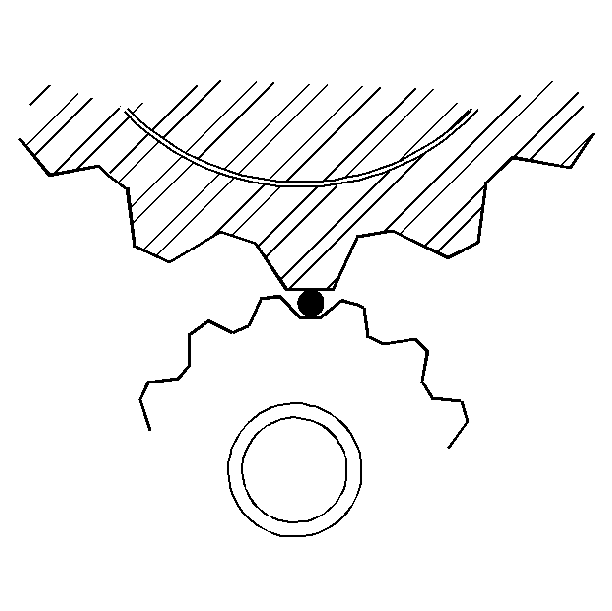Notice: Never operate the starter motor for more than 30 seconds at a time. Allow it to cool for at least two minutes. Overheating, caused by too much cranking, will damage the starter motor.
The diagnosis in this section covers mechanical problems only such as noises. For electrical diagnosis, refer to Electrical Diagnosis in Cell 30.
Starter motor noise could be caused by worn or damaged components, or incorrect pinion-to-flywheel clearance.
- Raise and suitably support the vehicle. Refer to General Information.
- Inspect the starter mounting bolts/screws for correct torque.
- Remove the transmission converter cover and inspect the flywheel teeth.
- Rotate the flywheel while observing the teeth. If any teeth are damaged or worn, the flywheel must be replaced.
- Measure the flywheel-to-pinion clearance.
Tighten
Tighten the bolts/screws to 47 N·m (35 lb ft).
Notice: Use the correct fastener in the correct location. Replacement fasteners must be the correct part number for that application. Fasteners requiring replacement or fasteners requiring the use of thread locking compound or sealant are identified in the service procedure. Do not use paints, lubricants, or corrosion inhibitors on fasteners or fastener joint surfaces unless specified. These coatings affect fastener torque and joint clamping force and may damage the fastener. Use the correct tightening sequence and specifications when installing fasteners in order to avoid damage to parts and systems.

| 5.1. | Disconnect the negative battery cable. Refer to
Caution: Unless directed otherwise, the ignition and start switch must be in the OFF or LOCK position, and all electrical loads must be OFF before servicing any electrical component. Disconnect the negative battery cable to prevent an electrical spark should a tool or equipment come in contact with an exposed electrical terminal. Failure to follow these precautions may result in personal injury and/or damage to the vehicle or its components. in General Information. |
| 5.2. | Disconnect the field lead from the starter motor solenoid terminal "M" and tape the end so it will not contact the solenoid. |
| 5.3. | Connect the negative battery cable. |
| 5.4. | Apply battery voltage to the starter solenoid terminal "S" and flash jumper terminal "M": to the ground. This will engage the pinion to the flywheel. |
| 5.5. | Using a wire type gage, measure the flywheel-to-pinion clearance. Clearance should be 0.5 mm (0.020 in). |
| 5.6. | Single shims installed on the outer bolt/screw are used to decrease clearance, double shims installed on both bolt/screws are used to increase clearance. Shims are not used when the engine is manufactured; they are only used as a service repair to correct a noise condition. |
Problem | Cause |
|---|---|
High pitched whine during cranking (before engine fires) but engine cranks and fires OK. | Pinion-to-flywheel distance too great. |
High pitched whine after engine fires, as key is being released. Engine cranks and fires OK. This intermittent complaint is often diagnosed as Starter Hang-in or Solenoid Weak. | Pinion-to-flywheel distance too small. |
A loud whoop after the engine fires but while the starter drive pinion is still held engaged. Sounds like a siren if the engine is revved while the starter drive pinion is engaged. | Replace the starter drive. |
A rumble, growl, or knock as the starter motor is coasting down to a stop after starting the engine. | Most probable cause is a bent or unbalanced armature. Replace the armature. |
